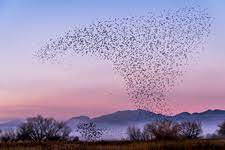By Michael Randall
When I was around ten years old and had a new BB gun, I shot at a robin high up in a walnut tree. I was stunned to see it tumble down through the branches to land gasping and dying at my feet. It looked up at me and I saw the life leave its eyes. At least in my memory, that was my first experience of anguish and remorse. That was a good age to experience such feelings, and I have grown to look with empathy on birds (and lots of other things big and small.)
How many times, when you pull up to a gas station pump, do small sparrow flocks flutter over from in front of a neighboring car to see how many dead bugs they can snatch from your car’s bumper and radiator before you fill up and move on?
House sparrows in New Zealand have learned how to flutter in front of cafeteria doors’ motion sensors. When the doors open, they fly inside and find food morsels, then flutter in front of the inside sensors to open the doors and return outside.
How many times have you seen a killdeer pretend to have an injured wing and try to lead you away from its exposed ground nest? (Are they very smart, though? I think they’re just a “one trick pony,” at least when nesting. And why do they build nests in such dangerous locations?)
How many times have we seen all the individual blackbirds within huge flocks maintain the same velocity and distance from those next to them, while the entire flock simultaneously and repeatedly changes direction in moves called “murmurations?” Together, they look almost magical, as though waltzing to orchestral music only they can hear. Each bird maintains awareness of several other birds closest to it and instantly mimics its neighbors’ actions.
Autumn is here and yesterday I saw my first big batch of blackbirds that already had begun flocking together. They swerved and danced through the sky ahead of my car. Amid those hundreds were two white “black birds” that flew side by side, perhaps the chance expression of recessive genes given life. The two had found each other; they soared and turned together and flashed in the sunlight amid the greater flock of their black brethren.
Many years ago, when my wife and I lived in a suburb of Seattle, I had big bird feeders in our backyard. Each spring, large flocks of ringneck pigeons came to eat at our feeders. Often, something would spook them and the whole flock would explode into the air and land high up in the surrounding maple trees, sometimes descending to the feeder moments later, sometimes just deciding to fly away.
On this particular afternoon, one bird remained on the ground after the rest had shot up into the trees. This bird was wobbly and its feathers looked bedraggled. I couldn’t tell if it was sick or injured, but it looked disoriented. It didn’t eat, didn’t move, as if concentrating only on remaining upright. The others watched it from high in the trees.
Finally, after a couple of minutes, two others flew down and landed beside their shaky companion. They stood close to its face, looked at it intently, as if to diagnose its problem. Both briefly pecked at the dirt, then looked at the unsteady bird, as if to say, “Come on. Eat. This is how you eat.” But the damaged bird simply stood there, unfocused, apparently unable to act on its own behalf. The other two remained with it for over twenty minutes, but finally gave up and flew off.
All the pigeons in the trees then departed at the same time. They had felt compassion, waited for their hurting companion, but finally decided its situation was hopeless, so flew away into the great world.
The following morning, I looked out at the bird feeder and saw that raccoons had come in the night. Close by was a scatter of bloody feathers. A bit later I went out and raked them up, then filled the feeders again.


